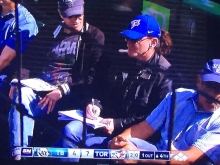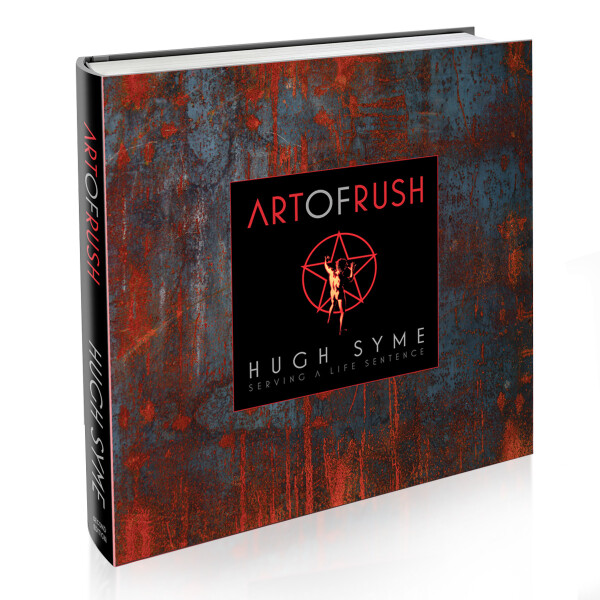 The Globe and Mail posted an article earlier this week on Sportsnet's recent decision to do away with a standalone radio broadcast of Toronto Blue Jays games and replace it with a simulcast called for both radio and TV. They asked seven prominent fans to weigh in on the decision, one of whom is Rush's Geddy Lee. As most Rush fans know, Geddy is a huge baseball fan and can often be seen sitting in his seats behind home plate at Toronto Blue Jays games. Here's what Geddy had to say:
The Globe and Mail posted an article earlier this week on Sportsnet's recent decision to do away with a standalone radio broadcast of Toronto Blue Jays games and replace it with a simulcast called for both radio and TV. They asked seven prominent fans to weigh in on the decision, one of whom is Rush's Geddy Lee. As most Rush fans know, Geddy is a huge baseball fan and can often be seen sitting in his seats behind home plate at Toronto Blue Jays games. Here's what Geddy had to say:
Geddy Lee, Rush singer-bassist and Blue Jays season-ticket holder
Some of my most memorable baseball memories were not from sitting in the stands or watching the game on the tube, but listening to the radio. Driving home from the cottage, I heard Dave Stieb's heartbreaking first one-hitter. There are nuances and descriptors that radio broadcasters share with their audiences that are simply not the same as a cabal of TV announcers, no matter how good they are. It's a time-honoured craft that requires a special ability to bring to life what we at home simply cannot see. This is a bad and regrettable decision.
 The Rush Backstage Club announced earlier this week that a newly expanded and updated second edition of Hugh Syme's The Art of Rush will be released later this summer; the original edition was released back in 2015. This updated edition includes a newly designed cover along with an additional 20-page section featuring the art of Rush's 40th anniversary releases. The Rush Backstage Club is also including a limited edition record flats pack containing several 12"x12" printed flats from the archives with every purchase. From the product description:
The Rush Backstage Club announced earlier this week that a newly expanded and updated second edition of Hugh Syme's The Art of Rush will be released later this summer; the original edition was released back in 2015. This updated edition includes a newly designed cover along with an additional 20-page section featuring the art of Rush's 40th anniversary releases. The Rush Backstage Club is also including a limited edition record flats pack containing several 12"x12" printed flats from the archives with every purchase. From the product description:
... Containing original illustrations, paintings, photography, and the incredible stories behind each album that Hugh Syme has designed with the band since 1975. The book's narration was written by music journalist Stephen Humphries and includes in-depth interviews with each Rush band member and the artist. The Art of Rush also contains entertaining anecdotes and commentary from a wide array of notable musicians, actors, athletes, writers, radio personalities, and Rush insiders about their favourite Rush album covers, which clearly reveals how vital and impactful the visual representation of their music has been through the years. One of the hallmarks of Rush releases is the considerable care and consideration that goes into each one-including the conceptual artwork. Readers may be surprised to discover just how much effort went into each concept and the execution for every album cover! ...
The book currently has an expected release date of August 2nd, and you can pre-order your copy via the Rush Backstage Club here.
 Prog magazine posted a guide to the writings of Neil Peart this past week, including their list of his 8 best books. Topping their rankings was Peart's 2002 book Ghost Rider (thanks RushFanForever):
Prog magazine posted a guide to the writings of Neil Peart this past week, including their list of his 8 best books. Topping their rankings was Peart's 2002 book Ghost Rider (thanks RushFanForever):
Following the double tragedy of losing his daughter Selena and his wife Jackie within 10 months of each other, Peart set off on his BMW R1100GS on an epic 55,000 mile journey to try and find some solace. He rolled across Canada, the US, Mexico and Belize - a ride Peart needed to take in order to soothe his "little baby soul" and nurture and protect it as best he could amid what he called the "wreckage" of his life. Ghost Rider is packed with journal entries, beautiful descriptions of flora, fauna and landscapes, the food Peart ate, the single malt whisky he sipped (mostly The Macallan), the places he stayed and the letters he sent to his friend Brutus as he pushed forward on his journey. It's a tough read in places due to the awful tragedy Peart endured, but his writing soars as he takes us with him down The Healing Road. ...
Kerrang magazine recently interviewed Voivod drummer and founding member Michel "Away" Langevin to talk about the band's legacy and his current projects. The subject of Rush and Neil Peart came up at one point and here's what Langevin had to say:
... "Of course, I first started to hear Rush in the '70s. I didn't know who they were, but that voice and style was so distinctive, and I would hear them on the radio. When I started drumming I studied the drumming very carefully and I was impressed that their drummer had a concept going and this whole lyrical world that he had created. There were two drummers that impressed me that way - Christian Vander from [French avant-garde prog group] Magma and Neil Peart. I was trying to figure out his drum rolls and I couldn't.
"When we finally toured with Rush in 1990 on the Nothingface album, I was at the side of the stage watching him and I still couldn't figure them out! Rush were really, really great to us and real gentlemen. After the first show we played with them, we went back into the dressing room and there was a bottle of champagne from them for us with a note that we gave to Piggy immediately because he was the world's Number One Rush fan. They were just so nice, but we were really quiet because what was I meant to say to The Professor?" ...
Total Guitar published a piece on 6 of the most famous guitar chords in the history of rock this past week and Alex Lifeson's Hemispheres chord was mentioned:
One hit of this chord with some light distortion and chorus and you'll instantly be in the sonic territory of Rush's Alex Lifeson. Alternatively, play it around the 5th and 7th frets for a Jerry Cantrell vibe.
WhatCulture.com posted an article this past week on 10 Rock Albums That Artists Regret Making and Rush's Power Windows was included at #10:
... It's not like Rush hadn't dabbled in electronic music before this though, with synths being a prominent part of their sound since A Farewell to Kings. Since it was the mid '80s though, this is where everything and the kitchen sink is brought into the mix, with Mystic Rhythms being the only thing that could be called a single from the record. While Neil Peart and Geddy Lee were still willing to go down this road, these songs ended up hitting a sour note with Alex Lifeson. With his signature guitar wails being pushed further and further into the background, Lifeson has always had a tense relationship with this record, oftentimes fighting with the rest of the band as to why he was looking for a different place when the keyboards were taking over. Despite returning to the loud guitars a few years down the road, Power Windows is still a powerhouse of a record if you're willing to look for a nice '80s throwback.
UDiscoverMusic.com posted their list of the 25 Greatest Prog Drummers this past week and Neil Peart came in at #2 behind only Bill Bruford (thanks RushFanForever):
We're not just getting sentimental here, even though Neil Peart's death in early 2020 still hurts. The man was a brilliantly inventive drummer who transformed the band he was in, joining Rush when they were still a workmanlike hard-rock outfit. Peart's various solos weren't just models of dexterity; they also had great riffs and even tunes. He also kept rhythm in mind while carefully choosing the words he'd use as Rush's lyricist. As a fan of big-band jazz (he produced two Buddy Rich tribute albums), Peart knew it didn't mean a thing if you couldn't make it swing.
In the latest edition of the Something for Nothing podcast, hosts Steve and Gerry continue their discussion centering around Rush's 2007 Snakes & Arrows album. You can listen in to part 2 below or via your favorite podcast service.
This past week's edition of the 2 Guys Talking Rush podcast features a continuation of last week's discussion on the sensitive topic of Rush and Religion with the assistance of Tom Beaudoin and Donna Halper. Donna is a Boston-based historian and radio consultant who is well-known to Rush fans as being credited with discovering Rush while working as the music director at WMMS in Cleveland back in 1974. Tom Beaudoin earned his Master of Theological Studies from Harvard University School of Divinity in 1996 and has a Ph.D. in Religion and Education at Boston College, and is also a massive Rush fan. You can listen to part 2 of the show below or at this location:
Last year an Indonesian drummer named Deden Noy began uploading videos to YouTube of himself performing drum covers by Dream Theater, Rush, and other rock bands. What set his drum covers apart was the fact that he used a homemade drum kit, but still managed to sound like a pro. He quickly became a viral sensation, and a crowdfunding campaign was started with the goal of purchasing Noy a professional kit. The campaign was unable to reach its goal of $1000, and that's when drummer Mike Portnoy stepped in (thanks RushFanForever). From Portnoy's Instagram page:
Over the past few weeks, I've gotten HUNDREDS (maybe even thousands?) of DM's, messages, texts, tags etc from people all around the world sending me links to @dedennoy playing a lot of my songs on his homemade kit. His talents are indeed incredible and I am in the process of arranging to get him a new kit & cymbals with the incredible support from @officialtamadrums and @sabiancymbals_official We'll keep you posted...
Here's Deden Noy's cover of Rush's The Spirit of Radio on his makeshift kit. He's also done Limelight and Tom Sawyer:
That's all for this week. Have a great weekend everybody!!

